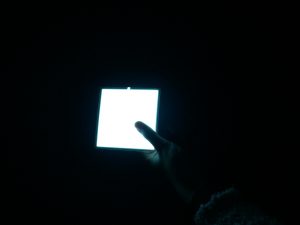
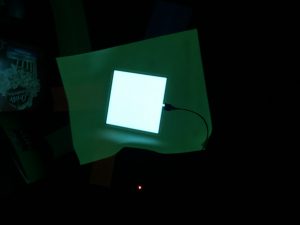
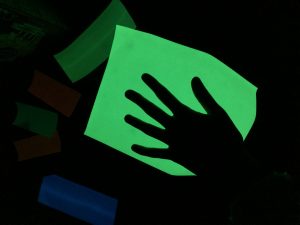
- –Finalized laser cut patterns, ordered el panel power source, and samples of neoprene
- –Trouble deciding on final sketches and design.
- –Plan on finalizing my sketches and finish final laser cut pattern design, I want to get to the laser cutter eventually and do a test pattern. I will also begin seam ripping my jacket and begin to make a flat pattern of off the jacket’s measurements. This I will need help on! I also plan on ordering final materials asap.
Week 3 Post – Haptic Glove
An image or video
- Tried to use high temperature to shape the wires
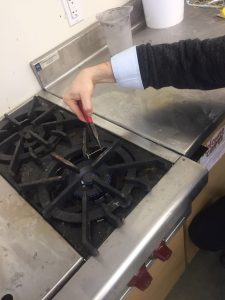
Tested the elasticity of the wires
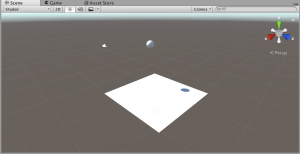 Bouncing ball scene in Unity
Bouncing ball scene in Unity
A Listing of accomplishments made by all group members for the previous week- Figured out how the wire worked and how to shape it
- Ordered new wires with better elasticity
- Created the bouncing ball scene in Unity
A description of problems encountered and outstanding issues
- Figure out what kind of glove do we need. (Thin, Good malleability, Thermal insulation)
- Still try to find a way to shape the wires
- Combine different functions in Unity to work together
- Figure out the best way to braid or twist the wire together to simulate the simulated effect.
A plan for the next week of work
- Test the new wire. If it works, we will implement it our gloves. If it does not work, we will go to our backup plan.
- Keep working on Unity
- Figure the best way to attach the wires to the glove without risk of superheating materials at the wire/SMA point of contact.
- Figure the best type of elastic band to use that will compliment the design as well as not melt to the connection.
- Start to consider aesthetics of the final product.
Changing Tides
- Last week
- Looked for parts at American Science and Surplus and found several types of motors and a hydraulic lift kit. After some contemplation and a realistic look at the time remaining to complete this project, I think I am going to pivot to my back-up plan and make and adjustable wedge instead of a heel. This will involve using a hydraulic scissor lift, which is much easier for me to understand than the rotary motor.
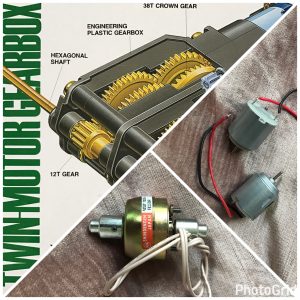
- Looked for parts at American Science and Surplus and found several types of motors and a hydraulic lift kit. After some contemplation and a realistic look at the time remaining to complete this project, I think I am going to pivot to my back-up plan and make and adjustable wedge instead of a heel. This will involve using a hydraulic scissor lift, which is much easier for me to understand than the rotary motor.
- This week
- Build scissor lift and shoe frame.
- Work on understanding the Bluefruit component.

Wearable Tactile Device
This was a project presented at the IEEEVR conference I attended last week.
Sirena 3/28/17
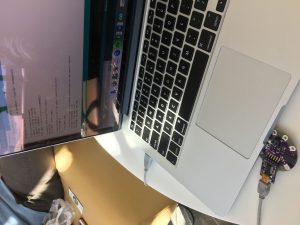
On Thursday Emma was figuring out how she could possibly 3D print part of the bracelet so all the tech won’t show or be felt when the bracelet is worn. Thought of using the 3D printer to print a sort of square box that the simblee and battery could sit in, which would allow the button to be pressed from the exterior wearer.
Planning to continue to work on the 3D printing concept this week using TinkerCAD.
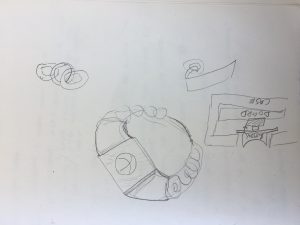
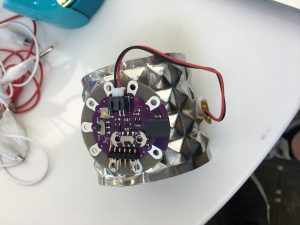 Using a large cuff right now to have an idea of what the prototype could look like.
Using a large cuff right now to have an idea of what the prototype could look like.
On Tuesday Keegan was able to get the Simblee up and running with code to use a vibration motor uploaded from computer to laptop. This was a step in the right direction, but the next step will be trying to upload code through Bluetooth not just through a corded connection. The Bluetooth on the Simblee was proven to work to at least his iPhone though the Simblee mobile application.
The uploaded Simblee Bluetooth code was for a temperature probe or just the internal temperature of the Simblee device. This code was fairly basic (and already completed) but it was still exciting to see the iPhone connect via Bluetooth and display a temperature value that actually responded to temperature changes.
Moving forward with code we want to work on how to program via Bluetooth and work on using time in the code. I haven’t quite figured how to work in sending a signal after a certain amount of time has passed. In my head it should be a simple if== “HIGH” for 3 s…then “do this” but the code has not worked out so simply.
EoS Post 3
Progress: This post is in the wake of a minor setback, I was unable to figure out how to use the previous range finder after spending a week poking and prodding it with various settings. So I started my fallback plan and ordered another range finder off of sparkfun, this one goes up to about 6 feet which is decent for showing the application of the EoS. It should arrive Thursday so I’m hoping I’ll have it before class.
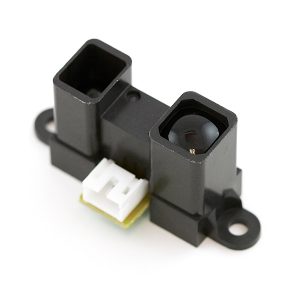
Problems: The biggest issue over the past 3 weeks was trying to decipher the cryptic range finder module I originally got. I’m receiving some sort of data from it but I could not figure out what it was/meant and it made minimal to no sense to me. I would get a value of 0 when measuring distance no matter what setting I’d use and I switched up to about every setting under the sun.
Plans: My plan for this week is to solder the arduino to the OLED screen and get that reading correct numbers. Then if I have the range finder I’d like to also solder that to the arduino and get the code written down. Lastly I will figure out my power needs and order the battery and the charger circuit, which when that all arrives I’ll be able to start creating some models of the casing I need since this new range finder is a different shape and size than the old one.
Unconventional Honesty Post 3
Hoorah! We finally got all of our project parts!
What we got in: 3 Neopixel strips, a heart rate monitor, a jacket to hack, and our lillypads!
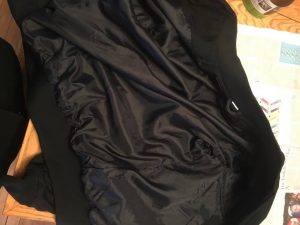
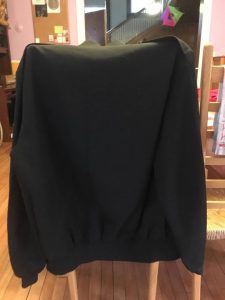
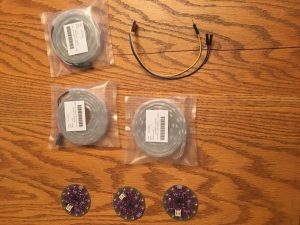
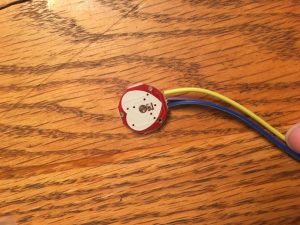
We have begun learning about the heart rate monitor and checking that we can process the information it collects.
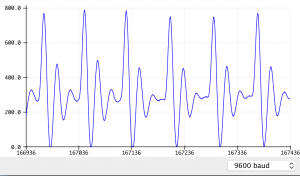
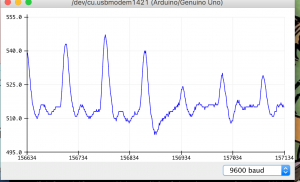
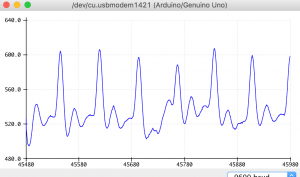
We have also begun hacking into the jacket by sewing the neopixel strips on and breaking into the lining.I have found difficulty with attacking the strips; I plan to look for easier ways to attach during class.
Our plan for this week: We’re going to complete our first mock up of the jacket, with attached neopixels, wiring, and functional heart rate monitor. We’re also going to look at the possible designs we can create with layers of neopixels!
Muscle jet Post#3
This past week I made a few test with the fiber optic.
1. Using only FO with a diameter of .25mm I weaved a 1.5 cm section, below you can see how it looks.
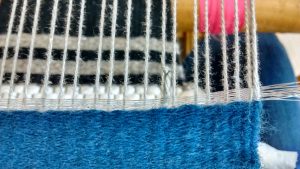
this FO is quite flexible and on the next video you can see it lights up enough to be seen in the dark after being sanded with a rough grade sand paper.
however it lacks structure, the FO slips through the warp
2. Using FO with a diameter of .50mm alternated with a cotton strand (?) I weaved a 1.5 cm section below you can see how it looks.
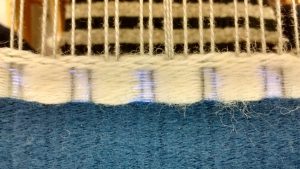
this FO is much less flexible, but the combination with the cotton gives more structure. On the down side alternating the FO hides half of it, as you can see in the video.
this one lights up more, so its pretty much a trade off between flexibility and surface area (the more surface area the more light).
Conclusions:
- Using a thinner cotton strand for the warp and the weft will allow the FO to show more.
- Instead of alternating FO and Cotton, I’l do a double weft FO + Cottton.
- I will sand the FO before weaving it, its harder but gives better results.
- It only looks cool on the dark.
Unconventional Honesty Post 2
We have started experimenting with out Neopixel designs and fabric overlay! We have videos of several fabric overlay options, but the MB are too large to be uploaded onto the site.
We have uploaded the videos to youtube!
Our most promising overlay is a double organza, which we would style into a vest over the neopixels. The interior of the jacket will have a quilt-like stitching into it so that we can hide pockets inside without compromising the aesthetic outside. We were also able to find the neopixel coding in Arduino which with will begin playing with to find the right design we want.
Our issues still remain with not having the sensor and neopixel strips, but we are expecting both any day now.
Plan for the week: Once we get in our final pieces we will attach to our first prototype, test run it, and start to work out the kinks! Over spring break, Jade will find a suitable fashion jacket to hack and we will begin working on our second prototype.
Step by Step
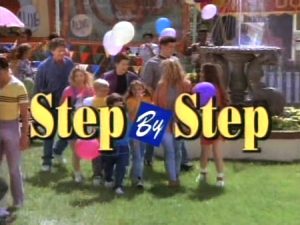
- Last week
- Heel Components
- The 1st version of the 3D prints for the heel component arrived. However, they did not fit in each other, so I tried modifying the physical components with a jewelry file to see if I could get them to fit. This caused the threads on the largest of the rings to snap.
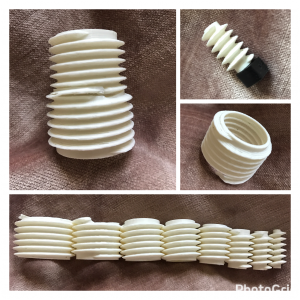
- Platform work
- I hollowed out the pre-existing platform of a heel that I own so that it can be used in the shoe until a custom platform has been fabricated.
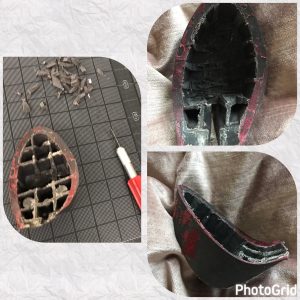
- Heel Components
- This week
- Heel Components
- I will continue to modify the 3D components and order the second version of the design.
- Bluefruit
- I will start to experiment with the Bluefruit components to see if I can get the device to work.
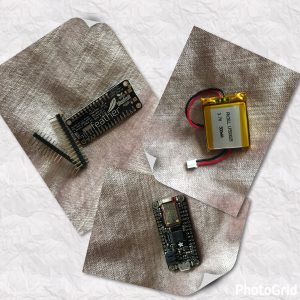
- Heel Components
- Next week
- Heel Components
- If the second version of the components function properly, I will order the final version in metal. Otherwise, I will continue to iterate and order new versions.
- Motor
- While in Milwaukee, I will go to American Science and Surplus to see if they have recommendations on small motors for the shoe.
- Bluefruit
- Once I have the motor, I will begin experimenting with the Bluefruit board to see if I can get it to spin the motor in two directions.
- Heel Components